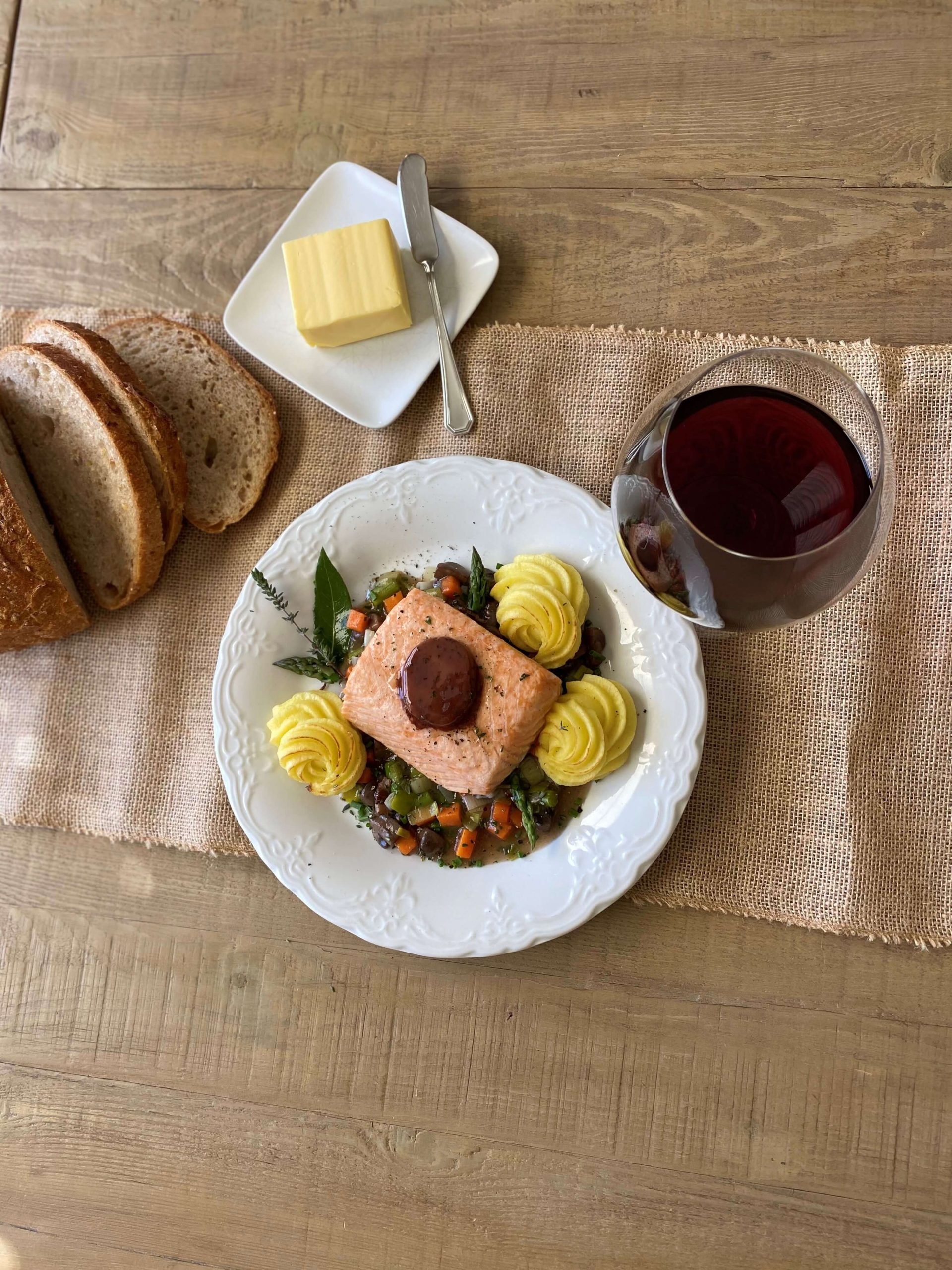Recipes
Salmon with Red Wine-Thyme Compound Butter And a Spring Vegetable Ragout

Ingredients
Ingredients 1
2 oz. smoked Bacon, diced
¼ lb. button mushrooms, cleaned and quartered
½ cup dry red wine
2 cups chicken stock
1 bay leaf
1 tbsp. fresh thyme, , finely chopped
1 large leek, rinsed of grit and sliced
1 ½ cups carrot, cut into small dice
8 asparagus, ends trimmed, blanched and cut into ½-inch pieces, tips reserved for garnish
2 ½ tbsp. cornstarch mixed with ¼ cup cold water
1 ½ lbs. salmon fillet, cut into 4 pieces
olive oil
Salt and pepper
Red Wine-Thyme Compound Butter, (see below)
2 tbsp. each chopped fresh parsley and chives, for garnish
Instructions
-
STEP 1:Begin ragout: Cook the bacon in a medium heavy-bottomed pot over medium heat, stirring often. Once the bacon is nicely browned, use a slotted spoon to remove the bacon to a small bowl. Set aside. Now add the mushrooms to the bacon grease and increase the heat to medium-high. Add a pinch of salt. Stir and cook the mushrooms for several minutes, until they are very brown and all their liquid has cooked away. Next, add the red wine and reduce heat to a simmer. Simmer the wine until it has reduced by about half. Add the chicken stock, the bay leaf and thyme. Cover the pot and simmer the mushrooms and liquid at a very low flame for about 20 minutes.
-
STEP 2:After 10 minutes, add the leeks and the carrot to the ragout. Continue to simmer the ragout until the carrots and leeks are tender but still have a nice, bright color. About 10 more minutes. Once the carrots and leeks are tender, stir the cornstarch mixture till it is smooth. Add about half the cornstarch mixture to the ragout and gently stir and cook for 2 or 3 minutes or till it is thickened like a gravy. Add more cornstarch mixture if necessary. Turn the burner off. Keep the ragout covered so it stays warm while salmon cooks.
-
STEP 3:Prepare the salmon while the ragout base simmers: Preheat oven to 325°F. Cover a sheet pan with a layer of foil. Place the salmon pieces, skin side down, onto the foil and brush them lightly with olive oil. Sprinkle the salmon pieces with a generous amount of salt and pepper. Place the sheet pan in the oven and bake the salmon for about 12 minutes. Check the salmon for doneness- it will probably need a few more minutes in the oven. It is properly cooked at 145°F, but some prefer their salmon a little less done than that. You can remove the salmon from the oven at about 135°-140°F and it will continue to cook and reach 145°F.
-
STEP 4:Finish ragout and plate fish: just before salmon is cooked, check the ragout for temperature and add the pieces of asparagus. Keep the tips separate for garnish. Reheat the ragout if necessary. Ladle about one cup of the hot ragout onto each of 4 serving plates. Slice 4 portions of the Red Wine compound butter, about 1/3-inch thick. Remove sheet pan from oven. Slide a large, thin spatula between the salmon pieces and their skin. Lift the salmon up, leaving the skin on the foil. Place each piece of salmon onto the hot ragout and quickly place a slice of the compound butter on top of each piece of salmon. Garnish the plates with the asparagus tips, parsley and chives. Makes 4 servings. Mashed or roasted potatoes, or pasta are nice accompaniments to this recipe.
-
STEP 5:Red Wine Compound Butter: 1 cup dry red wine* ½ lb. (2 sticks) butter, at room temperature ½ tsp. salt 1 tbsp. coarsely ground black pepper 2 tbsp. fresh chives, sliced ¼ cup fresh thyme leaves, very finely chopped
-
STEP 6:Pour the wine into a small, non-reactive sauce pan and place over medium heat. Once the wine begins to simmer, keep a close eye on it. As it reduces, reduce heat. This is a slow process; it can take up to 30 minutes. Once the wine has reduced to about ¼ cup remove from heat and set aside to cool.
-
STEP 7:Place the softened butter into the bowl of an electric mixer. Add the salt and pepper. Turn the machine on to low and mix the salt and pepper into the butter. Next, add all the reduced wine to the butter, using a little scraper if necessary. Mix on low to combine the wine into the butter. There will be some separation between the butter and the wine at first. Stop the mixer motor several times to scrape down the sides of the mixing bowl. The compound butter is done when there are no streaks of butter or wine to be seen. Add the fresh chives and thyme and mix in until evenly blended. Now the butter can be used as is or it can be put into small containers and frozen for weeks.
-
STEP 8:Another option is to make a log that can be sliced. Place a piece of plastic wrap onto a counter and place enough compound butter to make a thick, rough log, about 1 ½ inches thick and about 4 inches long. Wrap the log in the plastic and place into refrigerator for about 15 minutes. Remove the butter from the refrigerator and roll the log back and forth to smooth it out. Unwrap the butter and carefully wrap it once more to help avoid wrinkles/creases in the log of butter.
-
STEP 9:Replace the butter in the refrigerator until it is firm. It can be sliced at this point and used on top of hot, cooked items such as steak, fish, chicken or even pasta. This compound butter will keep a week or two in the refrigerator. Longer if frozen. Makes ½ pound compound butter.
Notes
*Chef’s Note: a darker, heavy bodied wine will yield a very dark color while a lighter, fruitier red wine will be more purple in color. Taste in the finished butter is nearly the same.






















































